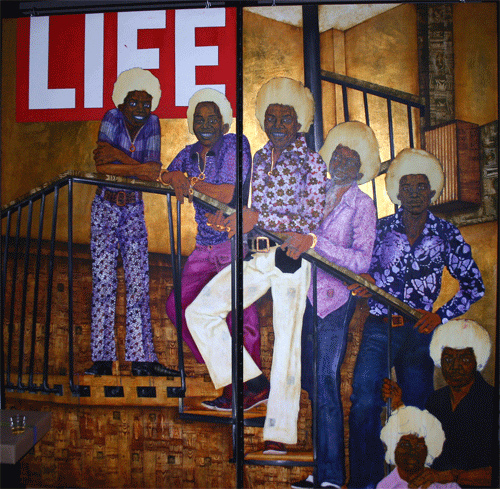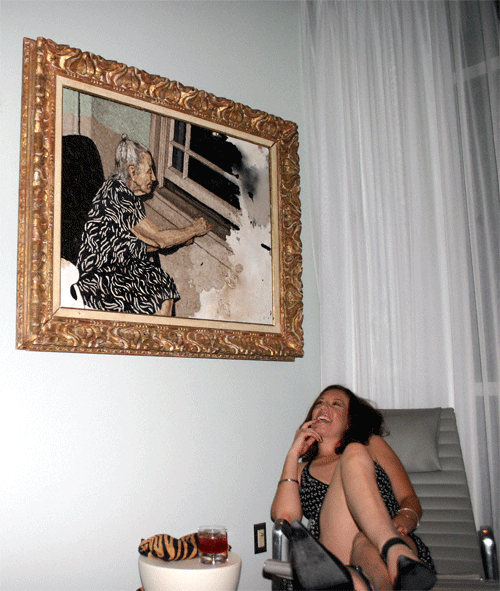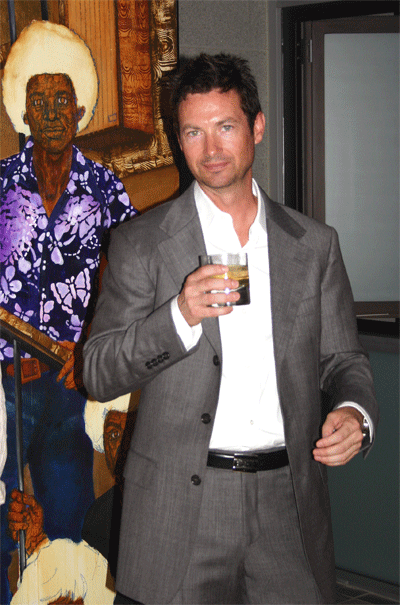Walking Up Catalina: Collector as Catalyst
In a departure from custom, mnartists.org runs this piece from Phoenix, AZ. It's about an art scene that's looking for ways to reach the next step, much like that in Minnesota. Here's a window to a parallel reality: can we learn anything from it?



Walking up Catalina Street, I stopped to check the address on the invitation when my friend Nicole nudged my elbow and said “Forget the card- look in that window!” Through the floor-to-ceiling plate glass behind a very large man dressed in bouncer-black was a much, much larger painting. Randy Slack’s twelve by eight foot monster “Welcome Home” bubbled with candy colors and gold leaf in the day-lit room
in front of us as we handed the invite to Treg Bradley’s birthday party at his condo in the Beadle View Lofts to the doorman.
It’s a strange feeling walking into the birthday party of someone you’ve just met a week ago, the feeling of being a bit of an imposter. As soon
as I was in the room being stared down by the painting I had first seen a year ago, however, the situation reversed. “So,” I said to the painting, “you live here now. Damn, nice job. Congratulations.” After a brief visit, we went upstairs to find the buffet and
look for our host.
The food was nicely presented, and I made a mental note, which I misplaced for several days, to find the name of the caterer. Mr. Bradley was not in the room, but a couple of dozen thirty-somethings with great shoes were. Behind the crowd
was the next flight of stairs, and hanging on the railing was another huge Randy Slack
painting, “At Home with Rock Stars and their Parents,” which depicts the Jackson Five
as photographed for a Life magazine cover back in the day. Hanging slightly above the
crowd, the painting had a trompe l’oiel effect like a mural bringing the Jacksons into the party. It was meeting Treg Bradley at the Chaos Theory show the previous week, and discussing his purchase of the Slack paintings and his near buy-out of the Hector Ruiz show now on exhibit at the Heard Museum, that had landed me here. Mr. Bradley, it was clear to me, is excessive.
Treg Bradley is not a typical anything. Raised in Gilbert on the outskirts of Phoenix in
an uncompleted Robert Frankenberger house situated in a pecan orchard, he began
gardening as a child. His mother took him to see Arcosanti, Paulo Soleri’s ecotopian
urban experiment in the Arizona desert, before he was in his teens. Later, impatient with college, he started his own business, Sea of Green Hydrogardens, in 1992 with a small loan from an investor. Focusing on hydroponics, growing plants without soil, he discovered that there were few organic fertilizers for sale. Seeing a gap in the market, Bradley found biochemists to work with and founded a second company, American Agritech, to manufacture organic plant supplements. Today there are three Sea of Green stores in Arizona, and American Agritech under the Botanicare name markets organic supplies to retailers and commercial growers nationwide. “It’s a lifestyle and a passion,” says Bradley, “it’s not a nine to five job.”
Asked what goals he has for his company, Bradley replied that he would like to see
indoor hydrogardens in every home. He wasn’t smiling when he spoke- there was no sense of whimsy or exaggeration in his speech. I didn’t know what to say. After a moment, Treg said, “Wait, I have a quote for you- One small act can multiply into many if you are conscious of the way and have prepared yourself for the opportunity- but there is inherent risk of failure if you have not framed well your objectives, and do not have an amazing mentor.” Amazing guy who can hear doubt and a question in silence- and have an explanation for the unasked question: “Why do you think you can do this?”
Walking past the Jackson Five painting on the second floor of the Catalina Street loft I saw Hector Ruiz, who had been sitting down, making himself invisible in the crowd. I
asked him why none of his works were on display at the condo, and he explained that the museum would be holding onto them for half a year. In fact, though he had received money for the sales of thirteen pieces, his new patron didn’t want possession of the pieces for two years, which would allow him to place the work in other museum shows. The Smithsonian’s National Museum of the American Indian (NMAI) had already planned to take some works in a collaborative group show designed by Heard Museum curator of contemporary art Joe Baker and NMAI curator Gerald McMaster.
Hector told us to check out the next exhibit at The Chocolate Factory, his gallery/studios on Grand Avenue. He is putting up works owned by three local artists that want to remain anonymous- a different kind of collector. Pieces by luminaries Julian Schnabel, Jeff Koons, and George Baselitz will be shown with works by Luis Jimenez and newcomers Barry McGee and Espo. Hector is calling the exhibit “The Secret Show.”
We grabbed drinks and hiked up to the next level, where we found paintings by other
local artists, James Angel and Colin Chillag. The Angel painting had been picked up some time ago by Bradley, but the Chillag piece was another recent purchase visiting for the party, and would be returned to the show at Modified Arts on Roosevelt Street in downtown Phoenix the next day. Looking at the Colin Chillag painting, we were joined by our host. Treg told us that the painting of an old woman next to a window, done in Chillag’s heavy oil impasto style, was his favorite in the house. I wondered at his choices of such dissimilar artists, but was struck by the strength of the individual pieces. So infectious was his enthusiasm that both Nicole and I claimed devotion to the painting. More than claimed, knew it.
A few days after the birthday party I set off to the Hector Ruiz show at the Heard Museum to have a calmer talk with Treg Bradley, and to meet with Heard curator Joe Baker to get his take on collecting. I’ve been privileged to know Joe since I moved to Phoenix over three years ago. Joe is just the sort of “amazing mentor” that Treg Bradley claims it is necessary to have if one is not to succumb to the “inherent risk of failure”
that is in any worthy project. The three of us had coffee at the museum café, and talked about architecture.
The lofts on Catalina Street were designed by Phoenix architect John Chonka, and became known as the Beadle View Row Lofts because they have a view of three
properties designed by beloved Valley architect Al Beadle. Phoenix, stuck on the northern edge of the Sonoran Desert, is an architects’ town, a city obsessed with buildings, a town searching for a different urbanity. Before Paulo Soleri came from Turin, Italy to build his two alternative city projects, Cosanti and Arcosanti, Frank lloyd Wright had moved his own utopian collective Taliesin to winter quarters in Arizona and founded Taliesin West. Both builders were obsessed with finding ways of building a community based on collaborative living and work.
Treg Bradley plans to build a house large enough to hold his growing art collection.
He has chosen Michael P. Johnson to design a sprawling single floor residence that will sit between the rocks scattered on the edge of North Scottsdale. Not content with taking care of his own needs, Bradley is collaborating with Johnson to build two family residences just south of the Camelback Corridor on one of the few remaining empty lots.
Bradley comments that most of the new residential dwellings being built in Phoenix are lofts intended for singles. He hopes to have an impact on local architecture by building
spec homes that offer a new alternative- something between the current choices of bachelor pad lofts, or exile to the burbs. Asked about his own impending move out of town, Treg explains that it will only be for a while. He wants to revisit the open environment he grew up in for a few years, but will someday return to the city center.
Collecting art is not like buying boutique architecture. Buildings, no matter how much loved, have a statistical value as real estate. As we walk through the Ruiz’ show “La Realidad” curator Joe Baker gives us some background: “Phoenix is different than LA or New York. These artists are part of a grassroots community. They give back to each other, they learn from and teach each other, they support each other’s vision. I don’t believe the coasts are looking at us now, but that makes it possible for something significant to happen here- something unique.”
There are many reasons people buy art. The smart money invests in Blue Chip pieces with auction records. The auction houses give art works a money track record, a price value akin to real estate, or coin collecting. When asked why he is supporting young local artists so intensely, Treg replied, “I figure I am a good catalyst or tool in having an impact on where I live. If you are positioned to have an impact and don’t act, it’s wasted. It does no good unless you have a cause and no good unless you act.”
Whether Bradley’s belief in the artists he is supporting becomes infectious, and becomes part of a trend, remains to be seen. For the moment, it is enough to know that one collector, at least, knows where his heart lives.
This piece was originally published in Java, Phoenix, AZ.